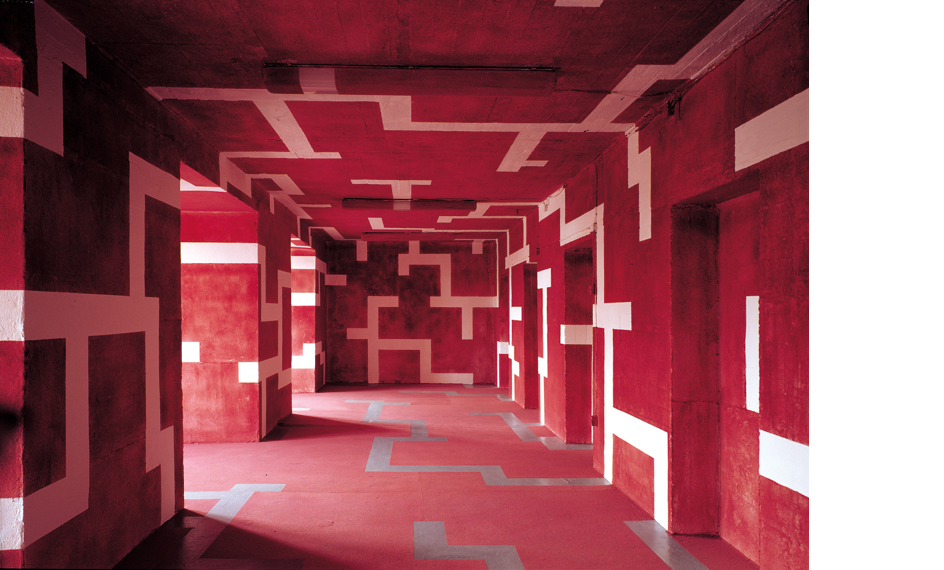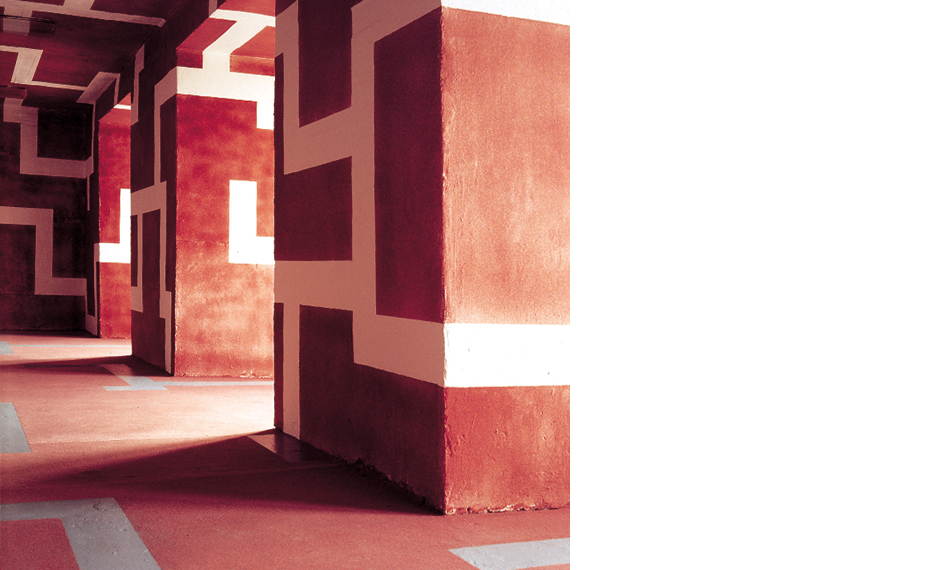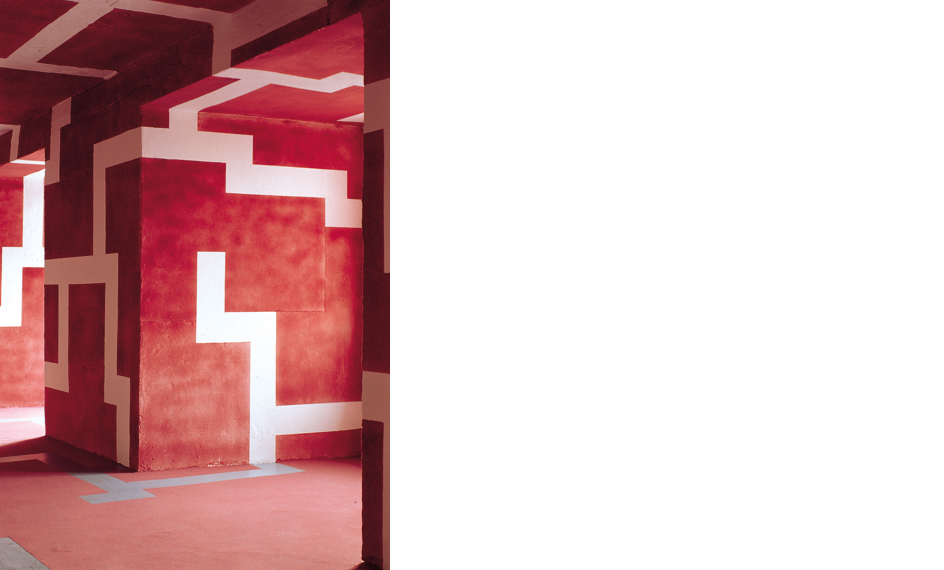over all
Förderverein Aktuelle Kunst, Münster 1998
Das Prinzip des Irrgartens, das Paradoxon einer Verwirrung stiftenden Systematik, bestimmt als konstituierendes Element die begehbaren Bilder Achim Zemans: Der Betrachter, der sich angesichts jeder Gabelung vielfachen Entscheidungsmöglichkeiten ausgesetzt sieht, verliert sich in einem Gewirr an Wegen, dessen vermeintlich willkürlicher Anordnung ein mathematisches Konzept zugrunde liegt. Ein mit Blick auf die Raumgröße berechnetes Quadrat bestimmt als Modul, als feste, stets ableitbare Größe durch Teilung oder Verdoppelung seiner selbst die Ausmaße der Wege und ihrer Begrenzungen. Der optische Eindruck täuscht über die mathematische Nachprüfbarkeit des Systems hinweg; die Visualität negiert den Rationalismus der Ordnung.
Achim Zemans Irrgarten 'over all' konstituiert seine Wegführungen aus aufgeflockten Nylonfasern, die sich in den vorgeschriebenen Demarkationen zu einem samtigen Flor verdichten. Der feinhaarige Auftrag, seine bisweilen filzartige Struktur, dämpft die Atmosphäre des Ortes, evoziert einen Grad an klaustrophobischer Stille, die sich in dem engen ehemaligen Schutzraum auch im Moment seiner unmittelbaren Bedrohung dereinst eingestellt haben mag. In der Farbgebung changieren die differenzierten Rottöne im Wechsel von Raumtiefe, Lichteinfall und struktureller Verdichtung der Fasern auf verschiedenfarbigem Grund: Gemahnt das mattschimmernde Rot bisweilen an getrocknetes Blut, so nimmt es andernorts unerwartet einen plüschigen, fast anheimelnd-bergenden Charakter an. Die dualistische Aussagekraft von Farbe und Materie korrespondiert mit dem zwiespältigen Erinnerungswert des Bunkers, der den Schutz des Lebens gewährleistet, in der Rückschau aber gleichermaßen seine Vernichtung symbolisiert.
Die Fragilität des stofflichen Auftrags, der bei leisester Berührung der Wände zerfällt, entmaterialisiert Zemans Farbraum im rezeptiven Prozeß: Die haptische Neugier des Betrachters, seine zwangsläufige Suche nach Halt, wird mit dem Griff ins Leere und der fortschreitenden Destruktion des vielgliedrigen Systems bestraft. Als temporäres Konstrukt ist dem Irrgarten die Verflüchtigung seiner Strukturen, die Zerstäubung der Pigmente und schließlich die Auflösung im Nichts unausweichlich vorbestimmt.
Achim Zemans plan ausgelegtes Vexierbild, das sich in der Begehung die dritte, tiefenräumliche Dimension erschließt, macht Blickrichtung und Schrittfolge zu Partnern der Rezeption, zu geheimen Verbündeten auf der Suche nach Orientierung. Der erlösende Ausgang, der Weg ins Freie, entläßt den Betrachter an einen Ort, der ihm das trügerische Gefühl von Sicherheit und Selbstbestimmung suggeriert. Doch der Irrgarten, in den er nun zurückkehrt, heißt - Welt: jenes Geflecht aus Lebenswegen, die sich parallelisieren, kreuzen und wieder trennen, um in schicksalhaft vorbestimmter Konsequenz einem letzten Ausgang zuzustreben, hinter dem nun aber nicht mehr die tröstliche Gewißheit wartet, das Altvertraute wieder vorzufinden.
Wolfgang J. Türk
The principle of the maze, the paradox of a system producing confusion, is the one component which determines Achim Zeman's walk-in pictures: The observer, faced at each fork in the path with a multitude of possible decisions, loses his way in a confusion of paths whose apparently arbitary arrangement is based on a mathematical concept: a square, calculated with regard to the available space, determines as a module, as a constant size from which are derived by division or by doubling the very dimensions of the paths and their limits. The visual impression deceives, confounding the mathematical demonstrability of the system; optics deny the rationale of order.
Achim Zeman's maze 'over all' constructs its paths out of flaked nylon fibres which compact themselves within the prescribed borders into a velvet pile. The fine-threaded layer with its sometimes felt-like consistency, muffles the atmosphere of the site, evoking a degree of claustrophobic silence which might fade in the confined former shelter even as it appears to threaten. In the colour scheme the different red tones vary in the alternation of the spatial depth, lighting and structural intensification of the fibres on their multicoloured base: while the dull glint of red sometimes reminds one of dried blood, in other places it unexpectedly assumes a soft, almost homely, sheltering appearance. The dual expressiveness of colour and material corresponds to the ambivalent memory of a wartime shelter
which offers protection for one's life but, in retrospect, also and equally symbolises its destruction.
The fragility of the material layer, which comes off the walls at the slightest touch, dematerializes Zeman's colour-space in the perceptive process; the tactile curiosity of the observer, his compulsive quest for contact, is punished with a grasp into the void and with the progressive destruction of the articulated system. As a temporary work, the maze is inescapably doomed to the transience of its structures and the pulverisation of its pigments, finally vanishing into nothing.
Achim Zeman's carefully disposed puzzle, whose third dimension in depth is revealed when one enters, transform the direction of one's tread into companions of one's perception, into secret accomplices in the quest for orientation. The exit into deliverance, the path to freedom, releases the observer at a point suggesting to him the false feeling of being able to survey, of feeling safe and of determining his own fate. But the maze into which he now returns is called - the world; that tissue of life paths which run parallel, cross and separate again, reaching in fatally predetermined logic for that last exit beyond which the comforting certainty of recovering the familiar no longer awaits us.
Wolfgang J. Türk




